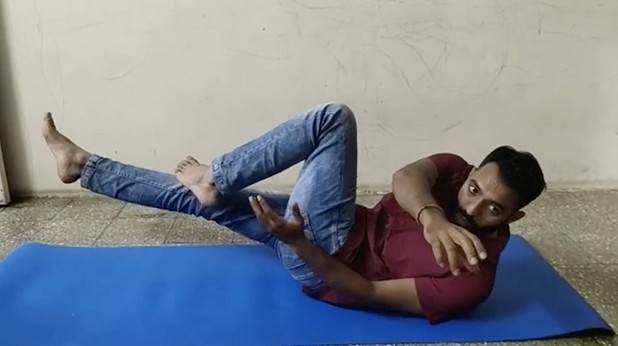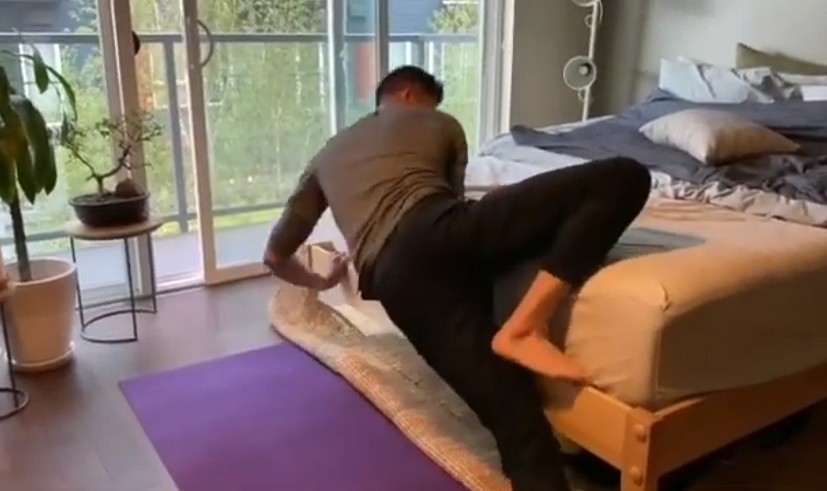
Writer Nutan Shinde and Dr Andrew Chen explore movement training at home. As many climbers still have no access to a climbing wall during lockdowns or quarantine, how can they train efficiently for climbing at home? While fingerboard and core exercises are good for maintaining strength, skill-focused training exercises are rarely used. The aim of the article is to provide movement exercises that can be trained at home.
When was the last time you really worked your muscles by training hard in the climbing wall? For most of us, it dates back to the pre-Corona period. Those were the times of training in the gym, climbing without masks, bouldering to exhaustion and working the moves until our forearm muscles popped out. Many of us miss training for climbing. Without a climbing wall, training at home is not as fun. We miss the actual climbing part of the training.
Since the advent of commercial gyms, we rarely think of home training. Crowded gyms, work commitments, family problems, long travel days are all reasons that have kept us away from gyms over the years. Despite that, we never find the time and space at home for building climbing skills, primarily because there is no climbing-specific workout.
Can you imagine practising heel hooks at home? The hip bridge is widely known as an exercise favourable for heel hooks. Even with raised hip bridges, do you think it's sufficient to train heel hooks? With these leg and other core exercises, it is possible to improve the strength to execute a heel hook. But what about the technique of a correct heel hook? How can you practise aligning the knee in the direction of the toe? It is possible to generate the exact forces and core activation required in a heel hook? You know the answer to these questions. Regular strength workouts are not designed for climbing movements. Distribution of forces, body balance and climbing-specific stresses are difficult to reproduce with these workouts. This is exactly the purpose of movement training, to add climbing elements to home training. Through innovative movement exercises, you can climb at home without a climbing wall. Before you make assumptions, I am not talking about those viral home climbing videos, but authentic climbing moves including heel hooks, gaston, flagging, and arm locking etc.
All of us are forced to skip climbing for other important priorities in life. For skill-based sports like climbing, creative movement patterns will help build skills. COVID19 has started a new era of training at home and movement training is making it revolutionary through climbing-specific exercises.
What is movement training?
Climbing movements like heel-hooks, drop knees, mantles, compressions, etc. are so unique that general muscle strengthening exercises are inadequate. Simulation of these moves that activate the same muscle groups, create the same stress, body tension, and balance is known as movement training. The idea is to analyse the various ranges of motion then mimic them at home to develop skills. "Movement training at home allows us to maintain the skills we've learned on the wall, load our main climbing muscles and tendons, and re-up our motor memory all in the comfort of our climbing wall-less home," states Movement Analysis Expert and Physiotherapist, Andrew Chen.
As various muscle groups function simultaneously it improves neuromuscular control and coordination of climbing movements. If strength training is for muscles, movement training is for mobility.
Movement training is becoming a familiar concept these days. The parkour style coordination moves and volume routes are challenging climbers more than ever. In response to these out-of-the-box movements, coaches are adopting movement training. Evolution of climbing has led to discovering unconventional exercises through movement analysis.
Movement Training at Home
Andrew has developed a unique series of drills that resemble climbing moves. He explains, "To create these drills, I simply interpreted climbing movements, broke down which main muscle groups were at work, and figured out positions or utilisation of home furniture to imitate the movement in stressful positions. All of my floor drills seek to challenge specific core activation, balance, and technique."
These climbing drills are easy to do at home with minimal equipment. Here are some of the movement drills to build climbing skills at home.
Rhythmic Climbing flow
I like to call it climbing on the floor. Grab two napkins and get ready to climb. The motions are similar to variations of a slider core workout. Flagging, elbow locking, reachy moves, balancing on 2-3 limbs are all movements we perform in our everyday climbing sessions. As you go from easy to hard difficulties, the number of limbs touching the ground changes from 3/4 in the easy-moderate version to only 2 in the hard version. This forces you to constantly reassess and revise your balance in order to maintain the position. I enjoy the flagging part most. I found the advanced variation hard at first, but over time this routine has built my core strength.
Do this continuously for 2-3 minutes and you will feel like you are climbing on the wall. All sweaty and pumped!
Heel Hook
It is a difficult move to grasp, but when used correctly it is the best technique to rest your arms while climbing. I remember struggling with heel hooks when I first learned the move. I was eagerly looking for a heel-hook specific workout in lockdown so that I didn't lose my grasp of the move. This unusual chair technique was perfect!
To practise this, all you need is a chair or sofa. Start by lying on the left elbow and placing the right heel on the chair. Slowly pick yourself up by engaging your heel on the chair. You can gain more motion using the left elbow and right leg on the floor. To start with you can use the right hand to take off. In the next version, try avoiding the right hand and raise it straight up. Suspending the right hand in the air mimics the flow of the heel hook where you immediately grab the next hold. This activates hamstrings exactly as it would if you were climbing. Make sure to keep the knee in the direction of the toes of the leg which is in the heel lock position. In the advanced version, you can raise the right leg above the ground.
Gaston Move
Who knew that a gaston could be trained for at home? Gastoning is one of the most shoulder- and arm-intensive moves that involves pushing of holds. Start by sitting in a boat pose and tucking your toes under something rigid so that they rise above the ground. Hold a theraband or resistance band in both hands and mimic the gaston position. Pull the theraband outwards to add more resistance. Then move both your hands up and down. This activates the targeted muscle group.
In the advanced version, get in a V-sit position and tuck one knee towards your stomach. This mimics the motion of changing leg positions while in a gaston move.
Mantle move
To master the mantle move all you need is your bed. The positioning is the same as the heel hook. Instead of heels, use the toes of your right leg. Hold the edge of the bed as you would grab a crimp or a pocket hold with the left hand and keep the right hand on the edge to imitate the push motion. Now try to pick yourself up by mantling using both hands and feet. Next time you want to sleep, don't crawl into your bed, just mantle!
Core Activation
These are my favourite of Andrew's movement exercises. I remember waking up with sore abs the next morning after only 3-4 reps of both exercises. This was a wakeup call for me to improve my core strength.
Abdominal Bracing Pulldowns
The first exercise is a modified hard version of a typical floor exercise. Fix one end of a theraband on a solid object. Lie on the ground on your back and hold the other end of the theraband in one hand. Now raise your legs above the ground (just like a leg-raise exercise) and bring them closer to your chest. As you do the legwork pull the theraband towards your chest. Do this for both the hands.
If this seems too hard, try raising only one leg and keeping the other on the floor. As you gain more strength, slowly raise the lower leg 1-2 inches above the ground.
The exercise becomes more advanced if you raise your back to go in a V-up position. Try to hold the theraband in both hands if holding in one hand makes you lose balance.
Modified Mountain Climber
Again it precisely mimics a climbing pattern as you slide your legs outwards and go from plank position to side plank, eventually extending the upper hand. You can increase the difficulty by wearing a theraband around both wrists. This increases resistance, activating rotator cuffs and abdominal muscles.
Plank Pulldown
The third exercise is a fun variation of the plank exercise. Just like we did earlier, secure a theraband onto something solid and get into the plank position. Move to a three-point position by extending one hand and grabbing the other end of the theraband with one hand. Now pull the band towards your chest.
You can add your own variations by moving the hand outwards in different angles to imitate grabbing a hold. This is a powerful climbing-specific exercise that works on lats, shoulders, core, forearms, and legs.
Shoulder Sliders
Instead of a theraband you can place your hand on a towel and slide it in various directions while remaining in the three-point plank position.
Movement training for injury prevention
Movement analysis plays a key role in injury prevention. After evaluating the movement patterns, injury-free positions can be designed. It is then easy to reinforce safe positions which may be hard through a regular strength workout. Hip bridges will make you strong enough to implement the move, but it won't guarantee perfect technique or an injury-free position.
Consider the following image in which Andrew explains the correct heel hook technique:
Wrong heel and knee position: An injury-prone technique where the toe is rotated far outwards in relation to the knee. This causes the tibia to rotate at the knee joint, placing increased stress on the collateral and cruciate ligaments.
Solution - heel in direction of knee: Injury prevention technique where the hip is rotated further to align the knee with the toes. This prevents rotation through the knee joint, allowing muscular structures to load (glutes, hamstrings, gastrocs) and not the ligaments.
With perfect technique, the hip is rotated appropriately to maintain alignment of the knee and toes to load muscular structures, rather than ligamentous structures (which are prone to more serious injury). It's therefore important to practise various hip motions for injury-free positions.
Movement exercises for hip
The following movement exercises for correct hip activation are focused on knee and toe alignment for ideal injury-free actions. It enforces muscle memory and increases strength for a complete range of motion. All you need is a theraband and a little space. Don't take it too hard on your first try. Throughout the exercise, make sure your knee is in alignment with your toes.
Standing Hip external rotation
Hip openers and activators
Hip flexion + Abduction
Design your own Movement exercises
Taking inspiration from Andrew, my husband Deepak Pawar - who is a climbing coach - and I have designed our own movement exercises. The first one, we call it monkeying on the floor. There is no specific pattern, we try to mimic the climbing flow on the floor. The focus is to keep core activated, increase hip mobility and explore possible positions of four limbs. With good music and a climbing partner, it is just like dancing on the floor.
Monkeying on the floor
The rest of the movement routines are a motivation from Adam Ondra's visualisation method he used while attempting his 9c project, Silence. These are basically modifications to the Boat Pose core exercise to imitate climbing moves.
Crossover moves
Spiderman Climbing move
Summary
When asked how beneficial movement training is, Andrew says: "In physical therapy, we have the saying 'Use it, or lose it'. If you don't use or practise your skill, you won't have it later when you need it. Also, something is always better than nothing. If that something is very specific to climbing, it's going to be much better than nothing."
Movement training is instrumental in skill-building. My motivation for trying these unique movement exercises was to maintain my skills during lockdown. Only after practising them, I realised that being able to train climbing-specific motions at home without a wall is a big bonus. I could learn skills and improve mobility with basic furniture and apparatus. These exercises can be done anywhere, anytime!
Movement training has given rise to a new spectrum of creativity and innovation. The canvas of movement training is like an empty climbing wall waiting for all of us to fill it in with our movement exercises.
Bio of Andrew Chen
Andrew Chen is a Movement Analysis Expert and Physiotherapist. He has been climbing for over 12 years with hard bouldering sends (up to V11/12). His interest in climbing led him to complete the Washington University in St Louis (WUSTL) PT program, renowned for pioneering Movement System Impairments. RocDocPT, he calls this as his passion project, where he provides Physical Therapy and Movement Training for climbing.
- ARTICLE: A Wave of Lockdown New-Routing in India 16 Feb, 2022
- ARTICLE: To Be a Climbing Mum, or Not to Be? 20 Jul, 2021
- ARTICLE: Facing the Samsara: Indian Women Climbing High 18 Feb, 2021















Comments
This is incredibly thorough and imaginative...but f**k me I'm glad I'm fortunate enough to have been able to build a small homewall at the start of lockdown ;-)
Great article thanks. Handy for those of us who still can't practically access climbing at all.